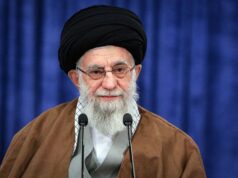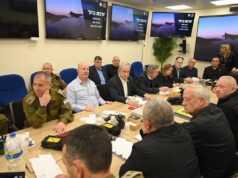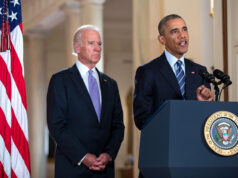THE HEAD OF HAMAS’S POLITBURO in Damascus, Khalid Mash’al, recently telephoned Sudanese President Omar Hassan al-Bashir and denounced the International Criminal Court’s accusations against him, according to an article that appeared on the Palestinian Maan News Agency website. The “armed wing” of Hamas also proclaimed Bashir’s innocence on their website.
Without addressing the allegations, Mash’al decried the submission of international organizations to U.S. pressure. He confirmed Hamas’s solidarity with Sudan, its leadership and people “in confronting this new conspiracy targeting Sudan through its head of state.”
The Islamic Republic of Iran also defends Bashir. Last year, as international pressure mounted over the slaughter in Darfur, Iranian President Mahmoud Ahmadinejad described Sudan as a second home full of “dear, pious and revolutionary brothers.”
Iran and Hamas like to cast themselves as defenders of “resistance.” Indeed, both claim to fight for justice and the downtrodden. How can they defend mass murder?
The story begins in1989, when an Islamist-inspired coup brought Brigadier Omar al-Bashir to power. Within months, Islamists tied to the National Islamic Front (NIF) held key posts in the government, security services, and other important sectors. As journalist Judith Miller noted, Sudan became “the only Sunni Arab state to have embraced absolutist, militant Islamic rule.” Weapons and oil supplies began to arrive from Iran. The two states, despite the Sunni-Shiite divide, became fast allies.
Allegations soon surfaced regarding Sudanese support for terrorism. To the consternation of the West, Sudan provided shelter to the infamous terrorist Carlos the Jackal, and also allowed Osama bin Laden and his nascent al Qaeda organization to train and operate out of Sudan for the first half of the 1990s.
In November 1991, Bashir banned mixed dancing and required women to dress according to Islamic standards. Transportation was also segregated. Finally, the government instated the Islamic hudud penalties (stonings, amputations, lashings, and even executions).
In December 1991, Iranian President Ali Akbar Hashemi Rafsanjani paid an official visit to Khartoum, accompanied by more than 150 Iranian officials. “The Islamic Revolution of Sudan,” he proclaimed, “alongside Iran’s pioneer revolution, can doubtless be the source of movement and revolution throughout the Islamic world.” Iran pledged $17 million in financial aid to Sudan, and arranged for an additional $300 million in Chinese weapons to be delivered there. Iran further pledged one million tons of oil each year.
Next, it was reported that Iran sent up to 2,000 Iranian Revolutionary Guards to Sudan. Iran’s Defense Minister, Ali Akbar Torkan also met with the commander of the Sudanese armed forces to discuss assistance and personnel exchange. By the end of 1992, Sudan’s Popular Defense Forces were unveiled. Sudan modeled its army after Iran’s Revolutionary Guards, who had trained them. Like their Iranian counterparts, the PDF marched with guns while reciting the Koran.
The West grew increasingly nervous over reports of terrorist training in Sudan. It was estimated that there were at least 10 paramilitary training camps in Sudan providing training to Palestinian Hamas and other Iran-backed terrorist groups. In 1993, the U.S. Department of State named Sudan a state sponsor of terror for, among other things, harboring bin Laden, and training Hamas with Iranian backing.
In November 1995, a military delegation from Iran visited Khartoum in order to make a new assessment of Sudan’s military needs, yielding Sudan a windfall of armored cars, heavy artillery, and radar equipment. In May of the following year, the two countries signed an agreement to broaden the scope of their cooperation.
The key broker for this relationship was an Islamist ideologue named Hassan al-Turabi. As one analyst noted, “the Muslim Brotherhood movement in Sudan is Turabi and Turabi is the movement.” By the late 1990s, however, Bashir removed Turabi from office in a power struggle.
While the West held out hope that Sudan was about to turn a corner, Bashir reiterated his commitment to sharia. As one academic observed, “the Islamist agenda has been pursued farther in Sudan than in many of the better-known examples of contemporary Islamic republics…”
Today, the U.S. State Department maintains that Sudan is a state sponsor of terrorism. Khartoum maintains close ties with Iran. But, the chief reason for designation is support for Hamas.
The three-way ties over nearly two decades explains the current Hamas and Iranian support for Bashir, and why they ignore the incontrovertible evidence of genocide. This yields two key observations.
First, both Sunni and Shiite Islamists are hypocritical and inconsistent when they proclaim that they seek justice.
More broadly, the Islamist support for the Darfur genocide reveals much about the dangers of Islamism, and must not be ignored.
Jonathan Schanzer, a former Treasury intelligence analyst, is the director of policy for the Jewish Policy Center. He is author of the forthcoming book “Hamas vs Fatah: The Struggle for Palestine” (Palgrave, Nov. 2008).





